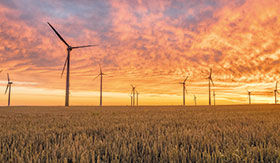

Governments around the world know the importance of supplementing fossil-fuelled energy with renewable energy in an effort to ensure a greener and cleaner environment for our planet. Wind is a renewable energy resource. There are no fuel costs associated with it and no harmful polluting gases are produced when using wind energy as an option to produce electricity. According to the 20 year Integrated Resource Plan (IRP2010), about 42% of the electricity generated in South Africa should be supplied from renewable resources in the near future. The Western, Eastern and Northern Cape are the leading provinces in wind energy in South Africa. All three of these provinces provide a suitable environment for wind farms thanks to the abundance of wind throughout the year.
When developing a wind farm, it is critical to optimise its layout for maximum efficiency. This process is called wind farm micrositing. The aim of such a process is to maximise the energy production of the wind farm, while minimising infrastructural and operating costs. For most projects, the economics are substantially more sensitive to changes in energy production than infrastructure costs. It is therefore appropriate to use energy production as the dominant layout design parameter.
Factors to be considered when micrositing include:
• Maximum installed capacity (due to grid connection or power purchase agreement terms).
• Site boundary.
• Turbine load constraints to avoid unfavourable wind conditions such as high shear, turbulence and extreme wind gusts.
• Turbine minimum spacing to reduce wake-induced turbulence and wake losses of downstream turbines.
• Set-back distances from roads, dwellings, overhead lines and ownership boundaries.
• Environmental constraints.
• Location of noise-sensitive dwellings and assessment criteria.
• Location of visually sensitive viewpoints and assessment criteria.
• Location of dwellings that may be affected by flickering shadows cast by rotating blades (shadow flicker) when the sun is in a particular position.
• Turbine minimum spacing, as defined by the turbine supplier.
• Constraints associated with communications signals, for example microwave link corridors or radar.
These constraints may change as discussions and negotiations with various parties progress, so this is inevitably an iterative process. The number of variables makes micrositing a challenging process, and it is an ideal candidate for advanced analytics that can crunch vast amounts of data to arrive at a scientifically optimal solution.
Some wind energy firms are using these prescriptive analytics to solve energy production problems that were once thought unsolvable. In 2016, Norwegian startup company, Markedslabben managed to solve its wind layout challenge, and by so doing improved its energy yield by 2 to 5%. The company employed the use of FICO’s Xpress Optimisation Suite in its algorithm to optimise wind farm layouts.
“While industry software previously has been capable of maximising energy yield by heuristics or genetic algorithms, no one has to date been able to incorporate load constraints into the optimisation,” said Klaus Vogstad, owner of Markedslabben (now known as WindFarmDesigns.com). “This means that consultants and manufacturers spend a lot of time checking layout solutions for load compliance, and adjust these layouts manually. This process is time consuming, and also achieves suboptimal results.”
Using a suite of optimisation tools from analytics software firm FICO, WindFarmDesigns managed to crack the code by incorporating load constraints in the layout optimisation problem using an MIP formulation with iterative relaxation. The resulting algorithm allowed the problem to be solved in just minutes for a typical windfarm size of 20 turbines. WindFarmDesigns now helps clients optimise wind power projects to be profitable and compliant and to help reduce CO2 emissions. “Our Xpress Optimisation Suite can go a long way in solving complex business problems. It gives you the tools you need to understand where you are as an organisation and the potential opportunities that are within your reach,” said Derick Cluley, head of operations at FICO South Africa. “By using the world’s most advanced optimisation software, wind energy producers and other businesses can quickly and easily solve massively complex business problems faster.”
For more information contact Britespark, +27 (0)11 655 7367, [email protected], www.britespark.co.za

© Technews Publishing (Pty) Ltd | All Rights Reserved